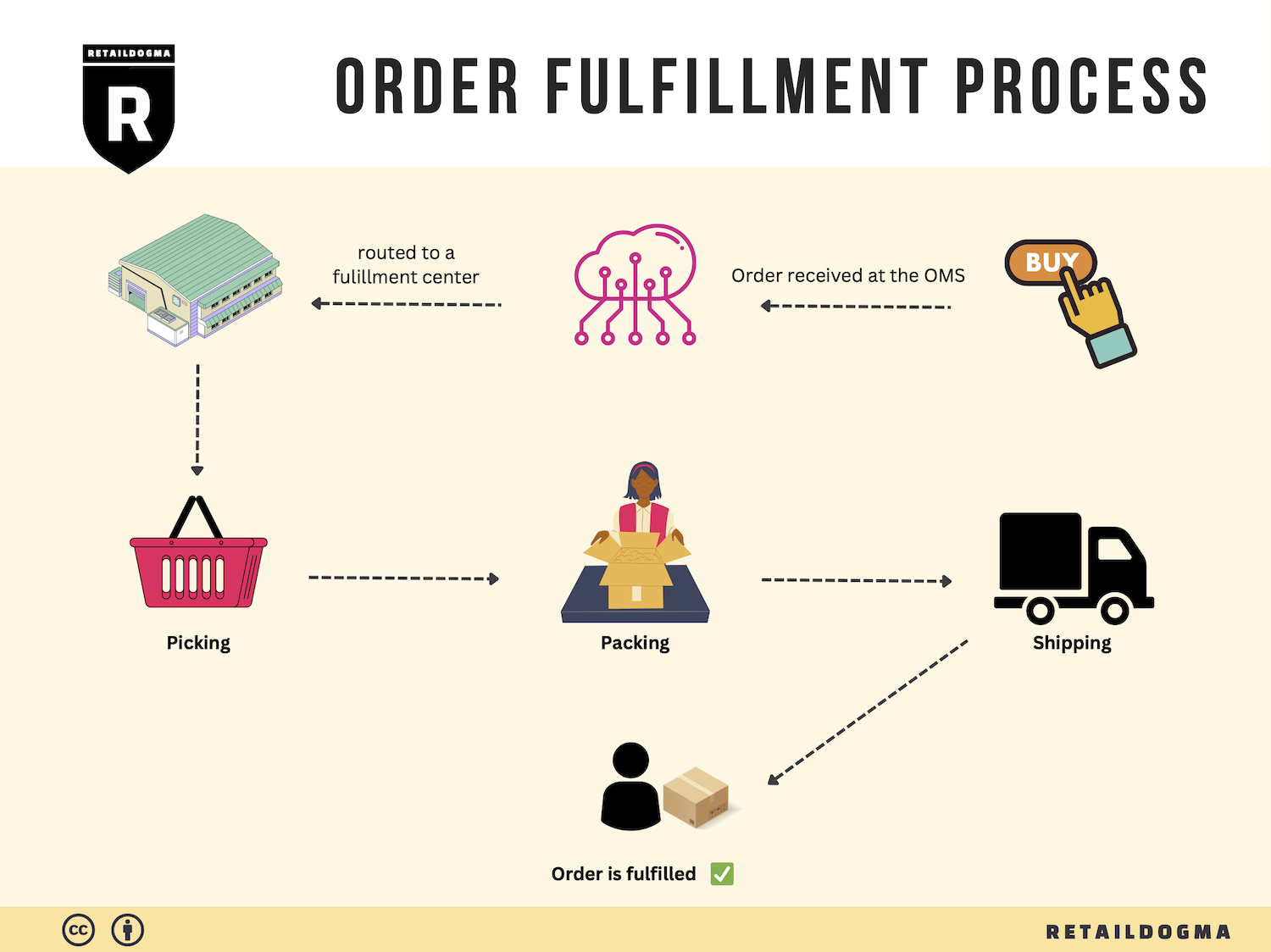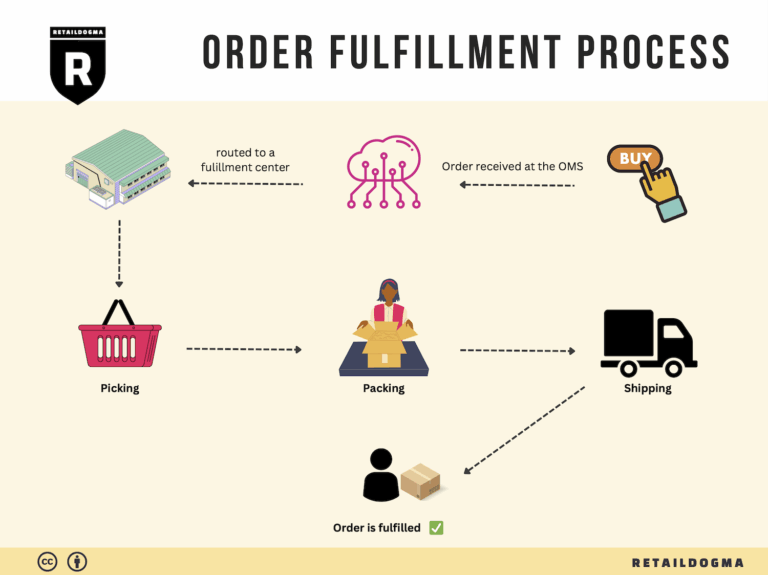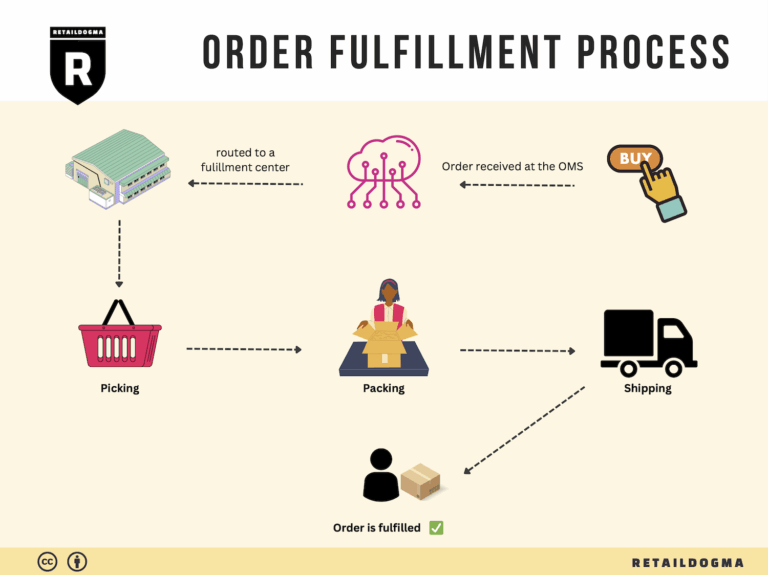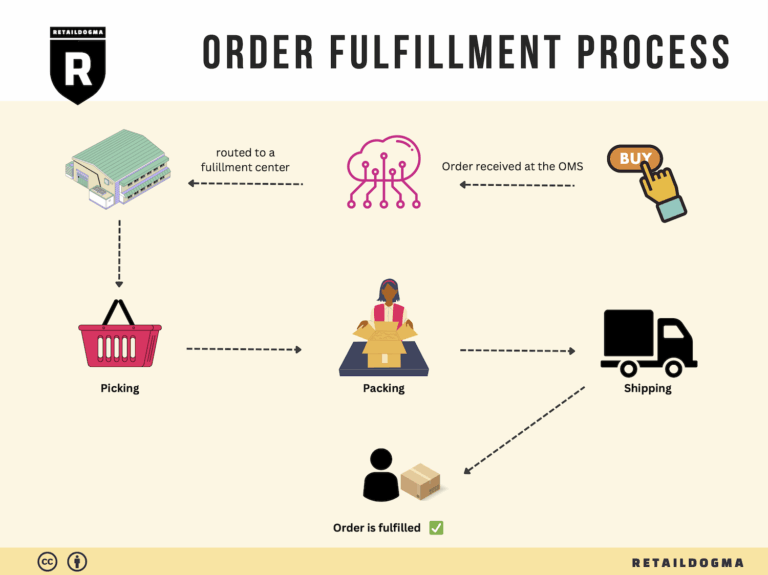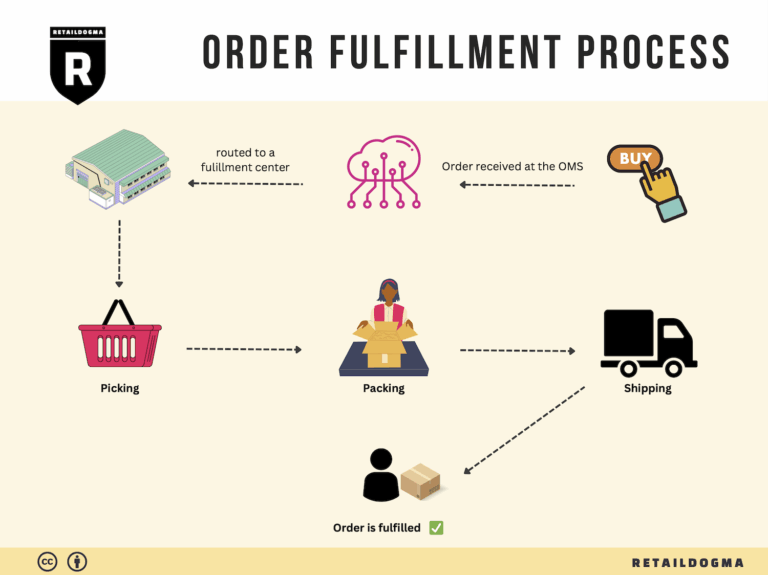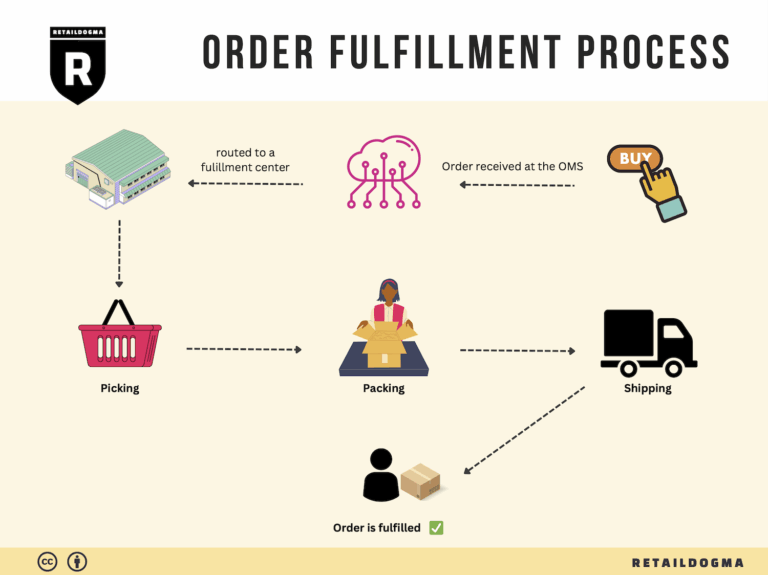Ecommerce Fulfillment Services: The Ultimate Guide (2025)
What is E-commerce Fulfillment? An Introduction for Growing Businesses
Understanding the Fulfillment Process
As an e-commerce business owner, you may find yourself grappling with a common challenge: the overwhelming task of packing and shipping orders. As your sales grow, so too does the complexity of fulfilling those orders efficiently. Managing inventory, ensuring timely delivery, and maintaining customer satisfaction can quickly become daunting tasks. This is where e-commerce fulfillment comes into play.
E-commerce fulfillment is simply the process of getting a product from your inventory to the customer’s doorstep. It encompasses everything from receiving and storing products to picking, packing, and shipping orders. For growing businesses, understanding the nuances of fulfillment can be a game changer, allowing you to scale effectively without sacrificing service quality.
This guide will explore various fulfillment models that can help streamline your operations. We’ll delve into Third-Party Logistics (3PL) and Fulfillment by Amazon (FBA), among other options, outlining how each can cater to different business needs. Understanding these models will empower you to choose the best fit for your operation, whether you prefer to manage logistics in-house or outsource them.
Additionally, we will cover the core services provided by fulfillment partners, including inventory management, order processing, and shipping logistics. Knowing what services are available will help you identify the right partner to align with your business goals.
Choosing a fulfillment partner is a critical decision for any growing business. We will provide practical tips on what to look for in a partner, including their technology capabilities, customer service standards, and geographic reach. These considerations will be vital in ensuring that your logistics operations are both efficient and scalable.
Lastly, we’ll tackle the topic of pricing. Understanding the cost structure of various fulfillment services is essential for budgeting and forecasting as your business grows. We’ll break down typical pricing models and help you analyze which options offer the best value for your specific needs.
The ultimate goal of this guide is to empower you—business owners and operations managers—to make informed decisions about your logistics strategy. By equipping you with the knowledge of e-commerce fulfillment, we aim to alleviate the stress associated with order fulfillment, enabling you to focus on what you do best: growing your business.
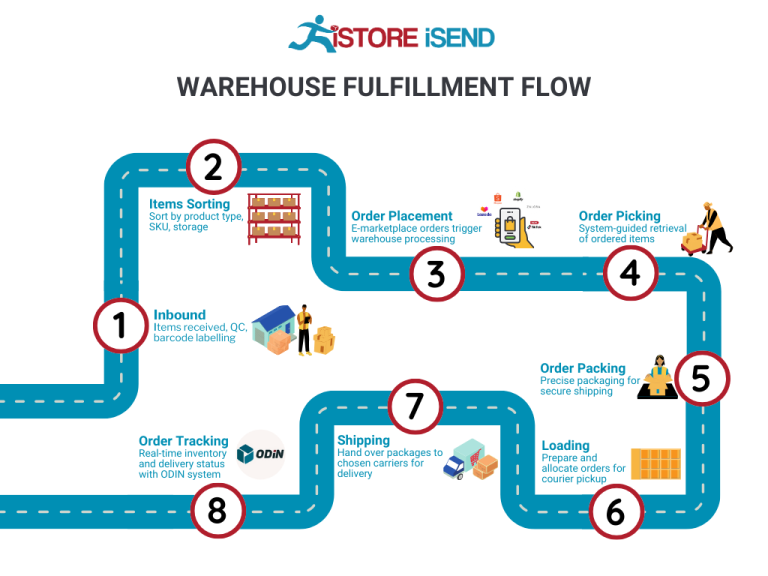
What You’ll Learn In This Guide
- What is E-commerce Fulfillment? An Introduction for Growing Businesses
- The Order Fulfillment Process: From ‘Buy’ Button to Customer’s Door
- Comparing Fulfillment Models: In-House vs. 3PL vs. Dropshipping
- A Deep Dive into Amazon FBA: Pros, Cons, and Who It’s For
- Core Services Offered by Fulfillment Centers
- How to Choose a Fulfillment Partner: A 6-Point Checklist
- Understanding Fulfillment Pricing: A Breakdown of Common Fees
- Frequently Asked Questions (FAQs) about Fulfillment
- Conclusion: Is Outsourcing Fulfillment the Right Move for Your Business?
- Important Disclaimer
The Order Fulfillment Process: From ‘Buy’ Button to Customer’s Door
1. Receiving Inventory
The order fulfillment process begins with receiving inventory at the fulfillment center. When products arrive, they are checked against purchase orders to confirm that the correct items and quantities have been delivered. This step is crucial as it ensures that the inventory on hand matches what is expected, which helps maintain accurate stock levels and minimizes discrepancies.
During this stage, each product is assigned a Stock Keeping Unit (SKU), which is a unique identifier used to track inventory. The use of SKUs allows for efficient inventory management and aids in streamlining subsequent processes. Proper receiving protocols not only prevent errors but also set the tone for the entire fulfillment operation. If inaccuracies occur at this stage, they can lead to cascading issues throughout the process, ultimately affecting customer satisfaction.
2. Warehouse Storage
Once the inventory is received and verified, the next step is warehouse storage. Products are organized within the fulfillment center in a manner that maximizes space and enhances accessibility. This organization can include various storage methods, such as shelving, pallet racking, or bin systems, depending on the nature of the products.
Efficient storage strategies are essential for quick retrieval during order picking. For instance, fast-moving items might be stored in easily accessible areas, while slower-moving products could be placed further back. Effective warehouse management systems (WMS) are utilized to optimize storage layouts and maintain real-time inventory levels. By ensuring that items are stored correctly, businesses can reduce picking times and improve overall operational efficiency.
3. Order Picking
When a customer places an order, the fulfillment process shifts to order picking. This step involves retrieving the correct items from storage to fulfill the order. Pick lists, which are generated by the WMS, guide workers to the locations of the required SKUs. This is a critical phase, as accuracy in picking directly influences customer satisfaction.
There are various picking methods, including single order picking, batch picking, and zone picking, each with its own advantages. For example, zone picking allows multiple orders to be processed simultaneously, thereby increasing throughput. The choice of picking method should align with the volume of orders and the layout of the warehouse. Efficient order picking minimizes delays and ensures that customers receive the correct products in a timely manner.
4. Order Packing
After the items are picked, they move to the order packing stage. During this phase, products are securely packaged to ensure they arrive at the customer’s door in perfect condition. This involves selecting the appropriate packaging materials, such as boxes, bubble wrap, or packing peanuts, and using tools like tape dispensers and scales to prepare the package for shipping.
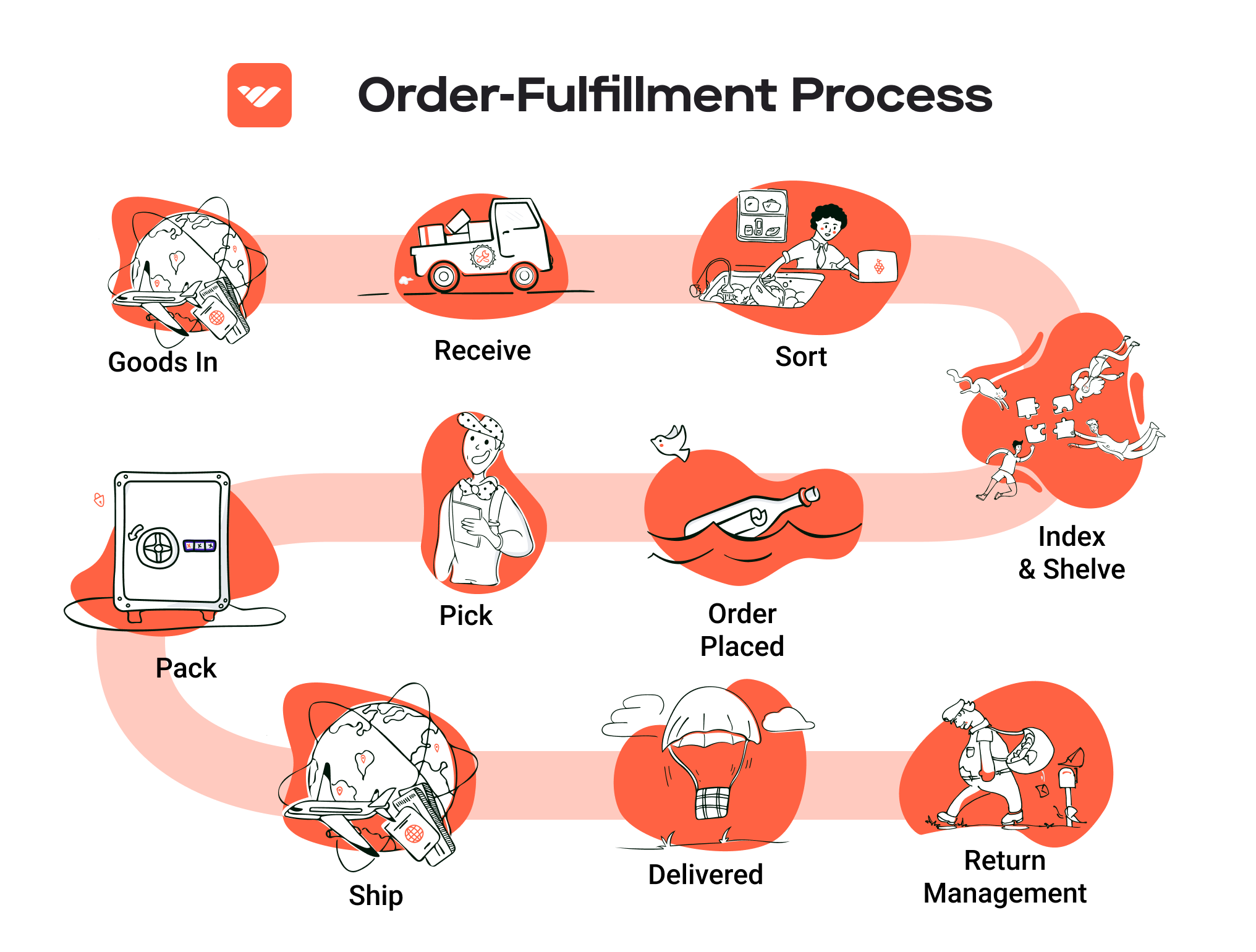
Packing is not just about protection; it also reflects the brand’s image. Thoughtful packaging can enhance the unboxing experience and encourage repeat purchases. Additionally, proper packing helps minimize shipping costs by optimizing the size and weight of packages. Businesses should also consider implementing packing slips, which provide customers with order details, further enhancing the customer experience.
5. Shipping & Delivery
The final step in the order fulfillment process is shipping and delivery. Once packages are packed, they are labeled and prepared for transport. Shipping methods can vary based on factors such as delivery speed, cost, and destination. Businesses often work with third-party logistics providers (3PLs) to manage shipping logistics effectively.
Timely shipping is essential for maintaining customer satisfaction, especially for e-commerce businesses that promise quick delivery times, such as those utilizing Amazon’s Fulfillment by Amazon (FBA) service. Orders may be shipped directly from the fulfillment center or routed through sortation centers for further organization before being dispatched to the final destination. Real-time tracking systems allow customers to monitor their orders, which enhances transparency and trust in the brand.
In conclusion, each step of the order fulfillment process is interconnected and crucial for delivering a seamless customer experience. By understanding and optimizing these processes, e-commerce businesses can scale effectively and improve their overall operational efficiency.
Comparing Fulfillment Models: In-House vs. 3PL vs. Dropshipping
Fulfillment Model Comparison
| Model | Who Handles Inventory | Best For (Business Stage) | Key Advantage | Key Disadvantage |
|---|---|---|---|---|
| In-House Fulfillment | The business itself | Startups to mid-sized | Full control over inventory and processes | Higher operational costs and complexities |
| Third-Party Logistics (3PL) | 3PL provider | Growth stage | Scalability and reduced overhead | Less control over inventory and customer experience |
| Dropshipping | Supplier | New entrepreneurs | Low startup costs and minimal risk | Lower profit margins and reliance on suppliers |
In-House Fulfillment
In-house fulfillment is a model where a business manages its entire inventory, storage, packing, and shipping processes internally. This approach provides the company with complete control over its operations, allowing for tailored processes that align closely with its brand identity and customer service standards. Companies that choose in-house fulfillment often invest in warehouse space, staff, and technology to manage their logistics.
This model is best suited for startups and mid-sized businesses that have a clear understanding of their inventory needs and customer base. They can benefit from the ability to customize their fulfillment processes and maintain direct oversight of their products. However, the key disadvantage lies in the higher operational costs and complexities involved. Businesses must handle warehousing, staffing, and technology investments, which can be particularly challenging as they scale. Additionally, in-house fulfillment can hinder flexibility, making it difficult to adapt quickly to market changes or spikes in demand.
Third-Party Logistics (3PL)
Third-party logistics (3PL) refers to outsourcing the logistics and fulfillment processes to an external provider. In this model, the 3PL company manages the storage, packaging, and shipping of products on behalf of the business. This approach allows companies to leverage the expertise and infrastructure of specialized logistics providers, which can lead to increased efficiency and cost savings.
3PL is particularly advantageous for businesses in their growth stage, where scaling operations quickly is essential. By outsourcing logistics, companies can focus on core competencies like product development and marketing while the 3PL provider handles fulfillment. A significant benefit of this model is its scalability; businesses can easily adjust their logistics needs based on demand without the burden of managing additional resources.
However, the reliance on a third-party provider can lead to challenges in inventory control and customer experience. Companies may find it difficult to maintain the same level of service quality or responsiveness when they are not directly handling fulfillment. Additionally, any issues with the 3PL provider—such as delays or inaccuracies—can reflect poorly on the business, impacting customer satisfaction.
Dropshipping
Dropshipping is a fulfillment model where the retailer does not keep products in stock. Instead, when a customer places an order, the retailer purchases the item from a third-party supplier, who then ships it directly to the customer. This model allows entrepreneurs to sell a wide range of products without the need for inventory investment, making it a popular choice for new businesses.
For new entrepreneurs, dropshipping presents a low-risk entry point into e-commerce. With minimal startup costs, businesses can test different products and markets without the financial burden of holding inventory. The model also allows for flexibility, as retailers can easily adjust their product offerings based on market trends and customer preferences.
However, dropshipping comes with its own set of challenges. One of the key disadvantages is the lower profit margins, as retailers often pay a premium for the convenience of having suppliers handle inventory and shipping. Additionally, reliance on suppliers can create potential issues with product quality, shipping times, and stock availability. As the retailer has less control over the fulfillment process, any missteps by the supplier can lead to customer dissatisfaction and damage to the retailer’s brand reputation.
Conclusion
Choosing the right fulfillment model is critical for e-commerce businesses looking to scale. Each model—In-House Fulfillment, Third-Party Logistics, and Dropshipping—has its unique advantages and disadvantages that align with different business stages and goals. Understanding these differences can help entrepreneurs and operations managers make informed decisions that support their growth strategies and enhance customer satisfaction. By carefully considering their operational capabilities, market demands, and long-term objectives, businesses can select the fulfillment model that best suits their needs and positions them for success.
A Deep Dive into Amazon FBA: Pros, Cons, and Who It’s For
Understanding Fulfillment by Amazon (FBA)
Fulfillment by Amazon (FBA) is a service provided by Amazon that allows e-commerce sellers to store their products in Amazon’s fulfillment centers. Amazon then takes care of the storage, packaging, and shipping of these products to customers, along with handling customer service and returns. This service enables sellers to leverage Amazon’s vast logistics network, which is designed to ensure quick delivery and high customer satisfaction.
When a seller enrolls in FBA, they ship their products to one or more of Amazon’s fulfillment centers. Once the products are stored, they become eligible for Amazon Prime, which can significantly enhance visibility and sales potential. When a customer places an order for an FBA product, Amazon picks, packs, and ships the order on behalf of the seller, often using its two-day shipping capabilities for Prime members.
How FBA Works
-
Product Preparation: Sellers prepare their products according to Amazon’s guidelines, which include labeling and packaging requirements.
-
Shipping to Fulfillment Centers: Sellers then ship their products to Amazon’s designated fulfillment centers. Amazon provides specific instructions on where to send each product.
-
Storage: Once received, products are stored in Amazon’s warehouses. Sellers can monitor their inventory through the Seller Central dashboard.
-
Order Processing: When a customer orders a product, Amazon takes care of the entire fulfillment process, including picking the product from the shelf, packing it, and shipping it to the customer.
-
Customer Service: Amazon also handles all customer service inquiries and returns, allowing sellers to focus on other aspects of their business.
-
Payment: After the sale, Amazon deducts its fees and transfers the remaining funds to the seller’s account.
Pros of Using Amazon FBA
Prime Eligibility
One of the most significant advantages of FBA is that products become eligible for Amazon Prime. This eligibility can dramatically increase sales, as Prime members tend to prefer products with faster shipping options.
Customer Trust
Amazon is a trusted brand, and products fulfilled by Amazon benefit from this trust. Customers often feel more secure purchasing FBA items because they know Amazon will handle their orders efficiently and provide customer support.
Multi-Channel Fulfillment
FBA can also be used for multi-channel fulfillment. Sellers can use Amazon’s logistics network to fulfill orders from their own website or other e-commerce platforms, not just Amazon. This flexibility can simplify operations and reduce shipping times for customers.
Scalability
FBA allows sellers to scale their businesses without the need for significant investments in warehousing and logistics. As order volume increases, Amazon can handle the additional workload, allowing sellers to focus on growth strategies.
Access to Advanced Analytics
Amazon provides sellers with detailed analytics regarding sales, inventory levels, and customer behavior. This data can help sellers make informed decisions about product offerings and marketing strategies.
Cons of Using Amazon FBA
High Fees
While FBA offers numerous benefits, it comes with associated fees that can be significant. Sellers pay for storage, fulfillment, and additional services. These costs can add up quickly, especially for slow-moving inventory, which incurs long-term storage fees.
Strict Inventory Rules
Amazon has strict rules regarding inventory management. Sellers must adhere to guidelines about inventory limits, product preparation, and labeling. Non-compliance can lead to additional fees or even suspension from the FBA program.
Commingling Risks
FBA products may be commingled with inventory from other sellers, which can lead to issues if a customer receives a product that is not from the original seller. This can negatively impact seller ratings and customer trust.
Loss of Control
By using FBA, sellers relinquish a degree of control over their inventory and fulfillment processes. This can be concerning for sellers who prefer to manage every aspect of their business closely.
Complexity in Returns
While Amazon handles returns, the process can be complex for sellers. Returned items may not be in sellable condition, leading to potential losses. Additionally, managing returns across multiple sales channels can become cumbersome.
Who is FBA Best For?
Fulfillment by Amazon is best suited for e-commerce businesses looking to scale quickly without investing heavily in logistics infrastructure. Here are some specific types of sellers who may benefit most from FBA:
-
Small to Medium-Sized Sellers: Those who may not have the resources to manage their logistics can leverage FBA to provide a professional level of service without the overhead.
-
Sellers with High Sales Volume: Businesses that can achieve high sales volumes can benefit from the efficiencies and shipping advantages of FBA, offsetting fees through increased sales.
-
Startups: New businesses that are just starting out can use FBA to access Amazon’s customer base and logistics without needing to build their own fulfillment operations.
-
Brands Seeking Visibility: Brands looking to enhance their visibility and credibility can benefit from Amazon’s trusted platform and Prime membership.
-
Multi-Channel Sellers: Businesses that sell on multiple platforms can streamline their operations by using FBA for order fulfillment across various channels.
In conclusion, while Amazon FBA offers robust advantages that can significantly enhance a seller’s ability to reach customers and streamline operations, it is essential to weigh these benefits against the potential drawbacks. Understanding your business model and target market will help you determine if FBA is the right fit for your e-commerce strategy.
Core Services Offered by Fulfillment Centers
Inventory Management & Warehousing
Fulfillment centers offer comprehensive inventory management and warehousing services, which are essential for e-commerce businesses looking to optimize their supply chain operations. This service involves the systematic organization, storage, and tracking of products within the fulfillment center’s warehouse. Advanced inventory management systems leverage barcoding, RFID technology, and real-time data analytics to ensure accurate stock levels are maintained.
Benefits:
1. Enhanced Accuracy: Automated systems reduce human errors associated with manual inventory counts, leading to more accurate stock levels.
2. Optimized Space Utilization: Fulfillment centers are designed to maximize storage efficiency, allowing businesses to store a larger variety of products in a smaller space.
3. Scalability: As e-commerce businesses grow, fulfillment centers can accommodate increasing inventory needs without the need for businesses to invest in additional warehouse space or management systems.
Pick and Pack Services
The pick and pack service is a core offering of fulfillment centers, where items are selected from inventory and packaged for shipment. This process involves picking the right products based on customer orders, packing them securely, and preparing them for dispatch. Fulfillment centers utilize sophisticated technology and processes to streamline this operation, ensuring quick turnaround times.
Benefits:
1. Speed and Efficiency: Fulfillment centers are equipped with optimized workflows that allow for rapid order processing, helping businesses meet customer expectations for fast delivery.
2. Quality Control: Many fulfillment centers implement quality checks during the pick and pack process to ensure that the right items are shipped in excellent condition, reducing the risk of returns and customer dissatisfaction.
3. Cost-Effectiveness: By outsourcing pick and pack services, e-commerce businesses can save on labor costs and overhead associated with maintaining in-house packing operations.
Kitting and Assembly
Kitting and assembly services involve the grouping of individual items into ready-to-ship kits or pre-assembled products. This is particularly beneficial for e-commerce businesses that sell products that require assembly or bundling before they can be sold. Fulfillment centers can handle these tasks efficiently, ensuring that customers receive complete products without the hassle of assembly.
Benefits:
1. Customization: Kitting allows businesses to offer personalized products or bundles, enhancing the customer experience and potentially increasing average order values.
2. Time Savings: By outsourcing kitting and assembly to fulfillment centers, businesses can save time and focus on their core activities such as marketing and customer service.
3. Inventory Management: Kitting can help in managing inventory more effectively, as fulfillment centers can keep track of both individual components and assembled kits, providing better insights into stock levels and sales trends.
Returns Management (Reverse Logistics)
Returns management, often referred to as reverse logistics, is a critical service offered by fulfillment centers that facilitates the processing of returned items. This service includes receiving, inspecting, and restocking returned products, as well as managing the logistics of returns. Efficient returns management is essential for maintaining customer satisfaction and loyalty in the e-commerce sector.
Benefits:
1. Streamlined Process: Fulfillment centers have established protocols for handling returns, which can significantly reduce the time and effort required for businesses to manage this aspect of their operations.
2. Cost Reduction: Effective returns management can help minimize losses associated with returned merchandise. Fulfillment centers often have strategies to quickly assess returned items, determining whether they can be resold, repaired, or recycled.
3. Improved Customer Experience: A seamless returns process enhances customer satisfaction, as it builds trust and encourages repeat purchases. Customers are more likely to shop with businesses that offer hassle-free return options.
In summary, utilizing the core services provided by fulfillment centers can greatly enhance the efficiency and effectiveness of e-commerce operations. From inventory management to returns processing, these services not only streamline logistics but also support businesses in delivering exceptional customer experiences, ultimately contributing to growth and scalability in the competitive e-commerce landscape.
How to Choose a Fulfillment Partner: A 6-Point Checklist
Location & Warehouse Network
Importance:
The geographical location of your fulfillment partner’s warehouses can significantly impact shipping times and costs. A partner with strategically located warehouses can facilitate faster delivery, particularly if they are near major transportation hubs or your customer base.
Questions to Ask:
– Where are your fulfillment centers located, and how do they align with my target market?
– What is your average shipping time to my primary customer locations?
– Do you have a network of warehouses that allows for regional distribution?
Technology & Integrations
Importance:
In today’s digital landscape, the technology used by your fulfillment partner is crucial for seamless operations. An effective fulfillment partner should have robust systems that integrate with your e-commerce platform, inventory management tools, and customer service systems to streamline processes.
Questions to Ask:
– What technology platforms do you use for inventory management and order processing?
– Can your systems integrate with my current e-commerce platform (e.g., Shopify, WooCommerce, Amazon)?
– Do you offer real-time tracking and reporting capabilities for inventory and shipments?
Specializations (e.g., Cold Storage, Oversized Items)
Importance:
Depending on your product type, you may need a fulfillment partner that specializes in certain areas. For example, if you sell perishable goods, a partner with cold storage capabilities is essential. If your products are oversized or fragile, you’ll need a partner experienced in handling such items.
Questions to Ask:
– Do you have any specializations in terms of product types, such as cold storage, hazardous materials, or oversized items?
– What measures do you have in place for handling sensitive or high-value products?
– Can you accommodate specific packaging or handling requirements for my products?
Scalability & Capacity
Importance:
As your business grows, your fulfillment needs will likely change. A good fulfillment partner should be able to scale operations to meet increased demand without compromising service quality. This includes having the capacity to handle seasonal spikes in order volume.
Questions to Ask:
– How do you handle increased order volume during peak seasons?
– Can you provide a clear plan for scaling operations if my business grows?
– What are your capabilities for inventory management during fluctuations in demand?
Pricing and Contracts
Importance:
Understanding the pricing structure and contract terms of your fulfillment partner is crucial for budgeting and financial forecasting. Look for transparency in pricing and ensure that there are no hidden fees that could impact your profit margins.
Questions to Ask:
– What is your pricing model (e.g., per order, per item, monthly fees)?
– Are there any additional fees for services such as storage, packaging, or returns?
– What are the contract terms, and is there flexibility for adjustments if my business needs change?
Customer Support & Reviews
Importance:
Reliable customer support can make or break your relationship with a fulfillment partner. You want a partner that provides timely and effective support to resolve issues as they arise. Additionally, checking reviews from other businesses can provide insights into the partner’s reliability and service quality.
Questions to Ask:
– What customer support channels do you offer (e.g., phone, email, live chat)?
– What is your average response time for support inquiries?
– Can you provide references or case studies from other clients in my industry?
Conclusion
Choosing the right fulfillment partner is a critical decision that can greatly influence your e-commerce business’s operational efficiency and customer satisfaction. By following this checklist and asking the right questions, you can ensure that your chosen partner aligns with your business goals and can support your growth effectively. Take the time to evaluate potential partners thoroughly, considering both their capabilities and their fit with your business’s unique needs.
Understanding Fulfillment Pricing: A Breakdown of Common Fees
Initial Setup Fees
Initial setup fees are one-time charges that businesses incur when they first begin using a fulfillment service. These fees typically cover the costs associated with onboarding, which may include account setup, integration with your e-commerce platform, and training on how to use the fulfillment system. The fee structure can vary significantly depending on the fulfillment provider, but it often ranges from a few hundred to several thousand dollars.
To get an accurate estimate, inquire about the specific services included in the setup process. Some providers may offer tiered pricing based on the complexity of the integration or the volume of products you intend to store and ship.
Receiving Fees
Receiving fees are charged each time a shipment of inventory arrives at the fulfillment center. This fee compensates the provider for the labor and resources involved in unloading, inspecting, and storing your products. Typically, receiving fees are calculated per pallet or per item, and can vary based on the size and type of products being received.
For instance, if your shipment consists of large items that require special handling, expect to pay higher receiving fees compared to standard-sized packages. It’s advisable to understand the provider’s policies regarding damaged or missing items during the receiving process, as these can also affect your overall costs.
Storage Fees (per pallet/bin)
Storage fees are incurred for the space your products occupy in the fulfillment center. These fees are typically charged on a monthly basis and can be calculated per pallet or per bin, depending on the provider’s storage model.
Storage costs can vary based on several factors, including:
– The size of the items being stored (larger items may incur higher fees).
– The duration of storage (long-term storage fees may apply if inventory sits unsold for an extended period).
– Seasonal fluctuations (many providers adjust storage fees during peak seasons, such as the holidays).
To optimize storage costs, maintain a lean inventory that aligns with your sales forecasts, and consider negotiating terms for long-term storage if you anticipate holding inventory for an extended period.
Pick & Pack Fees (per item/order)
Pick and pack fees are charged for the process of selecting items from storage (picking) and preparing them for shipment (packing). These fees are typically calculated per item or per order, depending on the fulfillment center’s pricing structure.
For example, if an order contains multiple items, you might be charged a base fee for the first item and an additional fee for each subsequent item. Some fulfillment centers offer volume discounts for businesses with higher order volumes, which can help reduce costs significantly.
When evaluating pick and pack fees, inquire about any additional charges for special packing requirements (such as gift wrapping or custom packaging) and consider how your product mix may affect these fees.
Shipping Fees
Shipping fees are one of the most significant costs associated with fulfillment services and can vary widely based on several factors, including:
– The shipping method selected (standard, expedited, overnight).
– The destination of the shipment (domestic vs. international).
– The weight and dimensions of the package.
Fulfillment providers typically have negotiated rates with major carriers, which may offer cost savings compared to retail shipping rates. Additionally, some providers may offer flat-rate shipping options for certain sizes and weights, which can simplify budgeting.
When calculating shipping costs, consider integrating your e-commerce platform with the fulfillment provider’s system to obtain real-time shipping rates at checkout, allowing customers to choose their preferred shipping options.
Conclusion: Tips for Getting an Accurate Quote
-
Specify Your Needs: Clearly outline your business model, including product types, order volumes, and expected storage duration. This information will help providers give you tailored quotes.
-
Ask for a Detailed Breakdown: Request a comprehensive breakdown of all potential fees, including any additional charges that may arise, such as for returns or special handling.
-
Compare Multiple Providers: Don’t settle for the first quote you receive. Compare offers from multiple fulfillment centers to identify the best fit for your budget and service requirements.
-
Consider Hidden Costs: Be aware of potential hidden fees related to inventory management, minimum order requirements, or seasonal price adjustments.
-
Negotiate Terms: Many fulfillment providers are open to negotiation, especially if you can commit to higher volumes or longer contracts.
By understanding these common fulfillment pricing models and following these tips, you can make informed decisions that enhance your e-commerce operations and ultimately support your growth objectives.
Frequently Asked Questions (FAQs) about Fulfillment
1. What is the Amazon Fulfillment Center-GRR1?
The Amazon Fulfillment Center-GRR1, located in Lansing, Michigan, is a large-scale warehouse facility that specializes in the storage, packing, and shipping of a wide range of products for Amazon. It plays a critical role in the logistics chain, ensuring timely delivery to customers across the region.
2. How does the fulfillment process work at GRR1?
At GRR1, the fulfillment process begins with receiving inventory from suppliers, which is then stored in the facility. When a customer places an order, the products are picked from the shelves, packed, and shipped directly to the customer. This process is designed for efficiency, leveraging advanced technology to streamline operations.
3. What is the difference between a warehouse and a fulfillment center?
A warehouse is primarily focused on storing goods, while a fulfillment center is designed to handle the entire order fulfillment process, including picking, packing, and shipping products directly to customers. Fulfillment centers often have additional services like inventory management and customer service support.
4. What is a third-party logistics provider (3PL)?
A third-party logistics provider (3PL) is a company that offers outsourced logistics services, which can include transportation, warehousing, and fulfillment. Businesses often partner with 3PLs to manage their supply chain more efficiently, allowing them to focus on core operations while leveraging the expertise and infrastructure of the 3PL.
5. How much do fulfillment services cost?
The cost of fulfillment services can vary widely depending on several factors, including the size and weight of the products, the volume of orders, storage space required, and additional services like packaging and labeling. On average, businesses can expect to pay for storage fees, pick-and-pack fees, and shipping costs. It’s essential to obtain quotes from various providers to find a service that meets your budget and needs.
6. Can I visit the GRR1 fulfillment center?
While Amazon does not generally allow public tours of its fulfillment centers, some locations may offer guided tours or educational programs for specific groups, such as business owners or students. It’s advisable to check with Amazon directly or visit their official website for any announcements regarding tours.
7. What types of products are stored at GRR1?
The GRR1 fulfillment center stores a diverse range of products, including electronics, household items, clothing, and more. The facility is designed to accommodate various categories, ensuring that Amazon can meet customer demand across multiple product lines.
8. How does GRR1 ensure fast shipping times?
The GRR1 fulfillment center utilizes advanced technology and efficient logistics practices to ensure fast shipping times. This includes automated inventory management systems, optimized packing processes, and proximity to major transportation routes, allowing for quick access to shipping carriers.
9. What should I consider when choosing a fulfillment center?
When selecting a fulfillment center, consider factors such as location, technology capabilities, service offerings, scalability, and pricing. It’s crucial to choose a center that aligns with your business needs and can adapt as your order volume grows.
10. How do I get started with Fulfillment by Amazon (FBA) using GRR1?
To get started with Fulfillment by Amazon (FBA) and utilize the GRR1 center, you need to create an Amazon seller account and enroll in the FBA program. After setting up your account, you can send your products to the GRR1 facility, where Amazon will handle storage, packing, and shipping on your behalf. Be sure to review Amazon’s guidelines for packaging and labeling to ensure compliance.
Conclusion: Is Outsourcing Fulfillment the Right Move for Your Business?
Evaluating the Benefits of Outsourcing Fulfillment
Outsourcing fulfillment can be a transformative decision for e-commerce businesses, offering a multitude of benefits that can significantly enhance operational efficiency. One of the most compelling advantages is time savings. By delegating the complexities of order processing, inventory management, and shipping logistics to a fulfillment service, business owners can redirect their focus toward strategic growth initiatives, product development, and customer engagement—activities that directly contribute to scaling their sales.
Additionally, outsourcing fulfillment provides scalability. As your business grows, so do the demands of your logistics operations. A reliable fulfillment partner can seamlessly adjust to fluctuating order volumes, especially during peak seasons or promotional events, ensuring that your customers receive their orders promptly. This flexibility is crucial in maintaining customer satisfaction and loyalty, which are vital for long-term success.
Moreover, partnering with a fulfillment center allows you to leverage expertise that may not exist in-house. Fulfillment services often employ advanced technology and best practices that enhance efficiency and accuracy in order processing. This expertise can lead to reduced shipping errors, improved inventory management, and ultimately, a better customer experience.
However, it’s essential to choose the right fulfillment partner to align with your business goals. A misalignment can lead to operational challenges and negative customer experiences. Take the time to evaluate potential partners based on their technology, geographical reach, and service offerings.
Call to Action
If you’re considering whether outsourcing fulfillment is the right move for your business, start by conducting an audit of your current shipping processes. Assess how much time and resources are being spent on fulfillment, and identify any bottlenecks or inefficiencies. This analysis will provide valuable insights into whether a fulfillment partner could enhance your operations and support your growth objectives. Making an informed decision now could set the stage for your business’s success in the future.
Important Disclaimer
⚠️ Important Disclaimer
The information in this guide is for educational purposes. Fulfillment services, pricing, and platform features change frequently. Always conduct your own due diligence and consult with providers directly before making business decisions.
